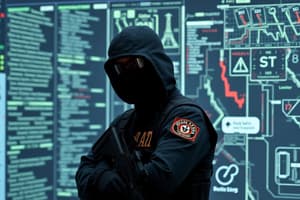Podcast
Questions and Answers
OSPEC is a five-step process to identify, control, and protect critical information.
OSPEC is a five-step process to identify, control, and protect critical information.
True (A)
Critical unclassified information is sometimes revealed by publicly available information.
Critical unclassified information is sometimes revealed by publicly available information.
True (A)
Could an adversary use the information about a service member telling a family member about a sensitive training exercise as an indicator for critical information?
Could an adversary use the information about a service member telling a family member about a sensitive training exercise as an indicator for critical information?
yes
Could an adversary use the information about a person leaving a facility with their ID badge as an indicator for critical information?
Could an adversary use the information about a person leaving a facility with their ID badge as an indicator for critical information?
Could discussing sensitive information in public, in person, or on the telephone be used by an adversary to obtain critical information?
Could discussing sensitive information in public, in person, or on the telephone be used by an adversary to obtain critical information?
Which of the following are good OPSEC countermeasures? (Select all that apply)
Which of the following are good OPSEC countermeasures? (Select all that apply)
A threat is an adversary that has the __________ + __________ to take any actions detrimental to the success of DoD activities or operations.
A threat is an adversary that has the __________ + __________ to take any actions detrimental to the success of DoD activities or operations.
An indicator is a comprehensive analysis of critical information by an adversary.
An indicator is a comprehensive analysis of critical information by an adversary.
Critical Information is ___________.
Critical Information is ___________.
Which one would be considered critical information?
Which one would be considered critical information?
Flashcards
OSPEC
OSPEC
A five-step process for identifying, controlling, and protecting critical information.
Critical Information
Critical Information
Unclassified and controlled unclassified information (CUI).
Threat (in OPSEC)
Threat (in OPSEC)
An adversary with intent and capability to harm DoD operations.
Indicator (in OPSEC)
Indicator (in OPSEC)
Signup and view all the flashcards
Publicly Available Info
Publicly Available Info
Signup and view all the flashcards
OPSEC Countermeasure: Geotagging
OPSEC Countermeasure: Geotagging
Signup and view all the flashcards
Critical Information Example
Critical Information Example
Signup and view all the flashcards
Indicator Example: Service Member
Indicator Example: Service Member
Signup and view all the flashcards
Indicator Example: Facility Exit
Indicator Example: Facility Exit
Signup and view all the flashcards
Indicator Example: Public Discussion
Indicator Example: Public Discussion
Signup and view all the flashcards
Study Notes
OPSEC Overview
- OPSEC (Operations Security) involves a five-step process to safeguard critical information and analyze actions that may reveal vulnerabilities to adversaries.
- Effective OPSEC measures protect against the exploitation of sensitive information by adversaries.
Critical Unclassified Information
- Publicly available information can sometimes expose critical unclassified information.
Examples of Indicators
- Sharing details about sensitive training exercises with family members can lead to unintentional disclosures if those details are later posted on social media.
- Failing to remove an ID badge when leaving a facility can provide adversaries with an indicator of personnel presence and security protocols.
- Discussing sensitive information in public settings or over the phone poses significant risks as adversaries may overhear and exploit this information.
OPSEC Countermeasures
- Photos taken with smartphones may have geotags that reveal locations; hence, being cautious with such media is important.
- Use social media judiciously and limit personal information to reduce the risk of exposure.
Threats and Indicators
- A threat is characterized by an adversary possessing both the intent and capability to undermine the success of Department of Defense (DoD) operations.
- An indicator itself is not a comprehensive analysis; it represents signs or markers that suggest what information an adversary may piece together about an agency's capabilities.
Definitions of Critical Information
- Critical information consists of unclassified and controlled unclassified information (CUI).
- Examples of critical information include deployment dates and locations that could jeopardize operational security if disclosed.
Studying That Suits You
Use AI to generate personalized quizzes and flashcards to suit your learning preferences.




